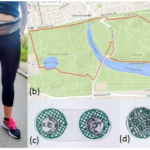 Whilst most amateur athletes now have some kind of tracking device, the industry has been rolling out a wide range of innovations lately to up the ante. I’ve covered a number of these on this site, including:
Whilst most amateur athletes now have some kind of tracking device, the industry has been rolling out a wide range of innovations lately to up the ante. I’ve covered a number of these on this site, including:
- the sweatband that monitors your hydration levels
- the quantified tennis court
- the prozone for amateur footballers
- the MoovNow AI coaching service
- the LumoRun smart fitness clothing
- the new range of Watson powered clothing from UnderArmour
- the new ski boots that track and provide feedback on your performance
It’s an impressive range of innovations, and I’ve quite possibly only scratched the surface. The latest innovation to be released via a team of researchers at King’s College London, who have developed a wearable device that measures muscle fatigue as we train.
The device, which was documented in a recent paper, tackles the tricky task of measuring muscle fatigue. It’s traditionally been difficult because measurement has involved gaining access to the electrical stimulation of nerves inside the muscle.
You can do it via the surface of the skin, but it requires careful placement of electrodes, and mistakes are easy to make if not medically trained. Add in the high cost of both approaches and it’s far from easy, especially outside of the lab.
Flexible measurement
The team have developed a cheaper, more flexible alternative that embroiders the electrodes into a pair of runners leggings. These then connect up to a portable Arduino microprocessor that collects the data and analyzes it for fatigue.
The device is stitched into the fabric to allow for stretching and is powered by a rechargeable battery.
By attaching the device directly to the fabric, the team believe that it will automatically ensure that the electrodes are positioned correctly, therefore removing the need for any expertise on the part of the user. What’s more, the electronics inside the device are relatively cheap to produce.
Hitting the road
The leggings were put through their paces on a range of surfaces, including an athletics track and a beach like environment, with runners completing 5km routes on each.
The data produced showed how the muscles were working throughout each run, with various rates of fatigue recorded for the different surfaces.
Whilst it’s well known that sand is harder to run on than asphalt, this is believed to be the first experiment conducted outdoors to really prove it. The team believe it could significantly change how athletes train and analyze their performances.
The hope is that the leggings usher in a new era of wearables that get to the very heart of your training and give you the data on your fatigue levels. It will certainly be fascinating to see how the product evolves, and whether other variants are developed, such as cycling shorts.
Watch this space.
Now that's pretty darn clever. I like it a lot.
I have a built in fatigue and dehydration sensor. Had it for years. It's called a "brain".
This device has no sense, because it is too expensive. And secondy, because your real limit of running isnt measured by muscle fatigue or energy, it is determinated by your physchology and spirituality – watch Forest Gump to understand